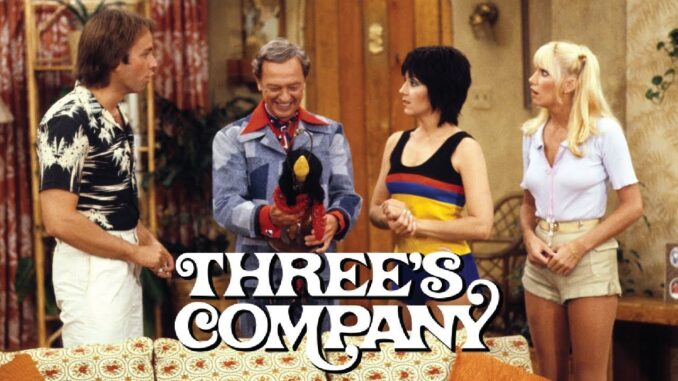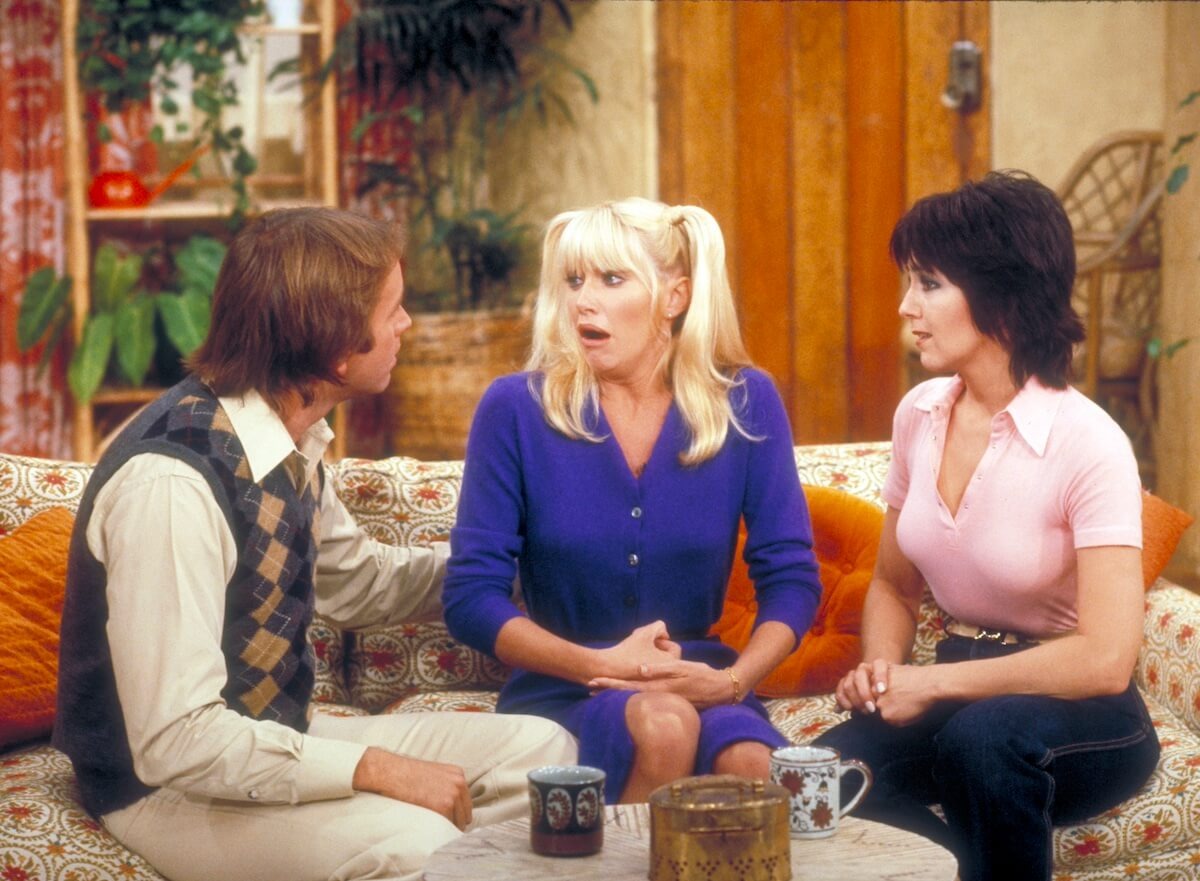
 There’s a universe in which ‘70s sitcom Three’s Company didn’t invite horny viewers to “come and knock on our door.” And even if they did, they probably wouldn’t have recognized John Ritter’s roommates if either of them answered. Entertainment publicist Danny Deraney recently shared the opening credits from the original pilot of Three’s Company, and it’s like a bizarro-world version of the popular sitcom. Only a few elements remain the same — mainly Norman Fell and Audra Lindley as the Ropers, the meddlesome and undersexed landlords, respectively. The rest looks familiar yet strange. The theme song has the same bouncy melody, but a cheerful “doo-doo-doo-doo-doo” replaces lyrics that promised “where the kisses are hers and hers and his, three’s company too.” There’s breakout star John Ritter, but he’s “David” instead of the familiar Jack Tripper. As for Chrissy and Janet? Both the characters and actresses have been replaced with comedy doppelgangers. Instead of Joyce DeWitt, there’s Valerie Curtin (cousin of SNL’s Jane) as Jenny. Replacing Suzanne Somers is the similarly named Suzanne Zenor as Samantha. And the producers completely cheaped out on the credits, superimposing actors’ faces over a static image of a Southern California apartment complex.
There’s a universe in which ‘70s sitcom Three’s Company didn’t invite horny viewers to “come and knock on our door.” And even if they did, they probably wouldn’t have recognized John Ritter’s roommates if either of them answered. Entertainment publicist Danny Deraney recently shared the opening credits from the original pilot of Three’s Company, and it’s like a bizarro-world version of the popular sitcom. Only a few elements remain the same — mainly Norman Fell and Audra Lindley as the Ropers, the meddlesome and undersexed landlords, respectively. The rest looks familiar yet strange. The theme song has the same bouncy melody, but a cheerful “doo-doo-doo-doo-doo” replaces lyrics that promised “where the kisses are hers and hers and his, three’s company too.” There’s breakout star John Ritter, but he’s “David” instead of the familiar Jack Tripper. As for Chrissy and Janet? Both the characters and actresses have been replaced with comedy doppelgangers. Instead of Joyce DeWitt, there’s Valerie Curtin (cousin of SNL’s Jane) as Jenny. Replacing Suzanne Somers is the similarly named Suzanne Zenor as Samantha. And the producers completely cheaped out on the credits, superimposing actors’ faces over a static image of a Southern California apartment complex.
A surprising name was behind this original pilot — Larry Gelbart, hot off the award-winning M*A*S*H. Gelbart’s Emmy-winning serio-sitcom about the Korean War was in another universe of sophistication from the jiggle comedy of Three’s Company, which is why he wanted nothing to do with the lowbrow concept. But ABC head honcho Fred Silverman called in a favor and Gelbart penned a script in with Jack, er, David as a filmmaker, Jenny a DMV employee and Samantha an aspiring actress. The pilot associated with this opening credit sequence nearly made it onto ABC’s schedule but was passed over for another show at the last minute. CBS swooped in with a cry of, “We’ll take it!” A nervous ABC agreed to add Three’s Company to their mid-season schedule, but only with a mostly new cast. The new pilot marked a tonal shift to an all-out sex farce, full of tight T-shirts, innuendo and bawdy misunderstandings. DeWitt was in, but the part of Chrissy went to an actress named Susan (that name again!) Lanier. ABC liked this pilot better, with the exception of Lanier. Based on her recent appearance on The Tonight Show, Somers was brought in for a third pilot — the one that finally landed a Tuesday night timeslot. The result? The highest-rated midseason show in history, at least to that point. Sometimes, the third time’s the charm. The tight T-shirts didn’t hurt either.
A Shocking Discovery: The Lost Version of a TV Classic
Imagine turning on your favorite classic sitcom, only to discover it was almost completely different. That’s exactly what happened when recently uncovered footage revealed an unaired version of Three’s Company—one that could have changed the course of television history.
This article dives deep into the unseen version of the iconic show, how it came to be, why it never aired, and why fans are buzzing like never before.
The Sitcom That Defined a Generation
Before we get into the lost footage, let’s rewind. Three’s Company wasn’t just a sitcom—it was a cultural phenomenon. Airing from 1977 to 1984, it broke barriers, sparked debates, and brought laughter to millions.
With its cheeky humor, loveable cast, and signature misunderstandings, the show quickly became a staple of American television.
Who Were the Original Stars?
You know John Ritter as Jack Tripper, right? But what if I told you he wasn’t always set to lead the show as we remember it?
Early versions of the pilot included entirely different actors. And the vibe? Wildly different from the upbeat, zany show fans grew to love.
The Unseen Pilot Episode: A Whole Different Story
So, what’s the deal with this lost version?
Back in the mid-70s, before ABC greenlit the Three’s Company we know, there were multiple pilot episodes. One of these, never aired publicly, featured a completely different cast and tone—more reserved, slower-paced, and lacking the spark that defined the final version.
Who Starred in the Never-Aired Version?
Before Suzanne Somers, Joyce DeWitt, and John Ritter became household names, producers experimented with other lineups. The first pilot starred Valerie Curtin and Susanne Zenor alongside Ritter. But chemistry was lacking, and the humor fell flat.
Why This Version Never Aired
Let’s be real: TV is a business. And when producers watched the first pilot, it was clear—this wasn’t going to work. The jokes didn’t land, and test audiences were underwhelmed.
Producers went back to the drawing board, recast the female leads, and cranked up the comedic energy. The rest, as they say, is history.How the Footage Was Found After Decades
You might be wondering—how did this footage stay hidden for so long?
Turns out, it was buried in the ABC archives, mislabeled and forgotten. A team working on a digital restoration project stumbled upon it and immediately realized its value.
From Dusty Vault to Viral Sensation
Once word got out, fans and TV historians freaked out. Clips began surfacing online, and within days, social media exploded with reactions, debates, and nostalgia-fueled excitement.
What Makes This Version So Different?
Beyond the cast, the vibe of the show felt completely different. The unaired pilot lacked the snappy banter and electric chemistry that would define the show’s success.
The set was more subdued, the pacing slower, and the jokes… well, let’s just say they needed a little seasoning.
Tone, Timing, and Trouble
The original script leaned heavily into awkward silences rather than witty comebacks. It was more of a traditional sitcom—safe, predictable, and, frankly, forgettable.
Thankfully, the producers took the risk to change it up.
How ‘Three’s Company’ Was Reborn
After that failed pilot, the creative team decided to rework everything. They brought in new writers, recast roles, and sharpened the humor. The retooled pilot introduced Chrissy Snow (played by Suzanne Somers), Janet Wood (Joyce DeWitt), and a more confident, charming Jack Tripper.
The chemistry was electric—and it showed.
A Risk That Paid Off
When the revised version aired in 1977, it was an instant hit. Viewers couldn’t get enough of the hilarious misunderstandings, risqué humor, and lovable chaos.
Had the first version gone to air, we might’ve never seen Three’s Company take off.
The Legacy of a Misfire
It’s easy to brush off a failed pilot, but this one is fascinating because it shows how close the show came to being something else entirely.
TV history was almost rewritten. One different decision, and the landscape of American sitcoms might look very different today.
Fans React to the Lost Footage
Once the footage hit the internet, long-time fans had a lot to say. Some appreciated the behind-the-scenes peek into what might have been, while others were shocked by how off the mark it was.
One fan tweeted: “I love Three’s Company, but wow, this pilot… it was like watching a rehearsal for a different show entirely!”
The Importance of Chemistry in TV Casting
What this lost episode really drives home is how critical casting and chemistry are in TV. You can have a great script, great set, and solid direction, but without the right mix of personalities? It just doesn’t work.
Ritter, Somers & DeWitt: Lightning in a Bottle
There’s a reason why the trio of Ritter, Somers, and DeWitt became iconic. Their comedic timing, natural rapport, and ability to deliver both laughs and heart made them unforgettable.
Could This Version Ever Be Aired Publicly?
At the moment, the full pilot hasn’t officially aired. But given the buzz and nostalgia factor, fans are pushing for a special release—maybe in a Three’s Company documentary or anniversary box set.
Why It Still Matters Today
We’re living in an age where lost media resurfaces all the time. From old movie scenes to unaired pilots, these discoveries remind us that even legends have rough drafts.
It also shows how much thought, trial, and error go into making something great.
Conclusion: A Forgotten Chapter That Deserves the Spotlight
The unreleased version of Three’s Company might not have had the magic we all remember, but its discovery opens a fascinating window into the creative process behind one of the greatest sitcoms in TV history.
It’s a rare look at what could’ve been—a reminder that perfection often starts with failure. And in a way, this lost pilot only makes us appreciate the show we got even more.
So here’s to the show that almost was—and to the brilliant team that had the courage to scrap it and start over.
